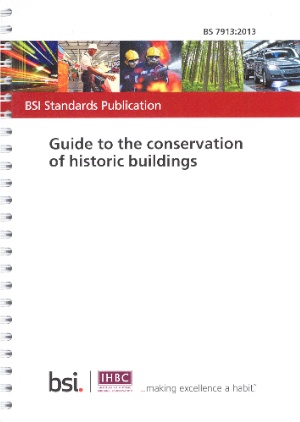There are some important British Standards that apply to old/ historic buildings, along with sections in UK building regulations (Approved Documents).
Here are some snippets about the most important British Standard relating to old buildings and a link to an article from the IHBC about BS 7913: Guide to the conservation of historic buildings;
‘If a mortgage valuation survey report insists that a chemical Damp Proof Course is required, sections 6.3.6.2 and 6.10.1 can be referred to. They make an authoritative argument to ensure that the cause of any dampness problem is properly dealt with. This is reinforced by section 6.3, on the need to assess a building’s performance and on the need for building pathology.
Here is the description of BS 7913 as described by the British Standards Institute;
BS 7913 describes best practice in the management and treatment of historic buildings. It applies to historic buildings with or without statutory protection. BS 7913 will take you through all stages from initially looking at a building through to the completion of appropriate work. It also guides you with information and sign posts to other resources.
Why should you use BS 7913?
- To provide background information on the principles and practice of the conservation of historic buildings and sites when setting conservation policy, management strategy, procedures and implementation.
- To provide professional expertise: the conservation of historic buildings requires judgement based on an understanding of principles informed by experience and knowledge to be exercised when decisions are made. British Standards that apply to newer buildings might be inappropriate.
- To balance conflicting pressure: conflicting pressures often need to be balanced to assist good decision making. This standard offer good conservation guidance based on sound research evidence and the use of competent advisors and contractors.
Who should use BS 7913?
This standards is a must have for those that own, use, occupy and manage historic buildings as well as the professional contractors and others employed to work on their behalf and may be used by decision makers and funders.
It will provide general background information on the principles of the conservation of historic buildings and sites, when setting conservation policy, management strategy and procedures for:
- Building owners
- Building managers
- Archaeologists
- Architects
- Engineers
- Surveyors
- Contractors
- Conservators
- Planners
- Conservation officers
- Local authority building control officers
British standard- BS 6576: Code of practice for diagnosing rising damp in walls and buildings and installation of damp-proof courses, quite clearly says; ‘Electrical moisture meter…Surface measurements cannot alone give proof of rising damp, so further evidence may, where permitted, be obtained by…measurements taken within the depth of the wall. Chemical (carbide) or gravimetric methods can be used.’
British Standard – BS 5250: Code of practice for controlling condensation in buildings,says; ‘Accurate measurements of the moisture content of brick or mortar cannot be obtained by the use of electrical moisture meters because the presence of salts increases the electrical conductance of the water, giving falsely high readings. Gravimetric methods carried out on samples taken from the fabric give the most reliable results. The use of chemical (carbide) absorption type moisture meters will give a result in a short space of time and are almost as reliable.’
https://www.designingbuildings.co.uk/wiki/BS_7913

